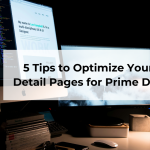If you are one of those companies that has decided to advertise on Amazon, it is a very wise decision. But do you know what your ACOS is? Do you know if your investment in advertising brings you profits or losses?
Many brands wonder what the ACOS is and how to get the most out of it based on their investment in advertising.
The ACOS is the relationship between advertising expenditure and advertising revenue. It is one of the main metrics to know the return on investment in advertising, ie measure the success of your advertising campaigns.
ACOS = Advertising expenses / Advertising revenues
To begin with, it is necessary to know the profit margin (ACOS of equilibrium) of your product. For the investment in advertising is profitable, it should not be spent on advertising beyond the profit margin of the product.
Knowing the ACOS break-even point is very important, as it allows you to see immediately if campaigns are generating profits or losses. ACOS balancing helps you make informed decisions about supply adjustments and other factors influence profitability.
If we want to improve our ACOS, where we have to focus is on the life cycle of the product: Offer – Printing – Click – Purchase.
It is easy to think how much lower the ACOS is, better, but it is not so. The fact of the ACOS increases is not necessarily bad, it depends on what the objective of the campaign is. If the objective of the campaign is to achieve as many visits as possible, rather than as many sales conversions as possible, it may be good for the ACOS increases.
For a more detailed understanding of the expense and revenue metrics that drive the ACOS:
Advertising Expenses = Clicks x Cost per Click (CPC)
Advertising revenue = Orders x Average sales price (MAP)
ACOS = Clics x CPC/ Orders x PMV.
At the same time, there are two other key metrics for ACOS: the Click-Through Rate (CTR) and the Conversion Rate (CVR).
What are the metrics that influence CPC, CTR and CVR?
First, we can see the Click-through Rate (CTR). This rate indicates how attractive an ad is as a result of users’ specific searches. When a user clicks on the ad, it is because he considers it relevant to the competition and he begins to consider the purchase of the product.
The CTR does not affect the increase or decrease of the ACOS as long as the conversion rate remains stable. Increasing the CTR is a good thing as long as the current ACOS is below its break-even point.
If the CVR is not kept constant, it is important to act on the CTR because it will affect the ACOS. To avoid damaging the ACOS, if you want to increase the CVR, the objective must be to increase the CTR with qualified traffic.
On the other hand, we find Cost per Click (CPC). It is very important because the CPC influences the ACOS to be the price of clicks that advertisers generate in their campaigns. It has a direct relationship with ACOS.
Finally, we have the Conversion Rate (CVR). This rate influences the ACOS because, lastly, the purpose of advertising is to drive conversion or sales. It has an inverse relationship with the ACOS.
Once the user has clicked on the advertisement, he confirms that it seems relevant to him. From then on, the PDP is in charge of convincing the potential customer to buy your product. The main objective of the PDP is to increase the CVR.
If my ACOS is too high, how do I lower it?
The first thing to do is to make sure that the PDPs are optimized in the best possible way (useful titles, bullets and descriptions that contain the most efficient keywords, photos and videos that visualize the benefits of the product, comments and ratings reflecting the positive experiences of customers).
To optimize ACOS the important thing is to manage your PPC campaign well through ongoing maintenance. This means you have to focus advertising spending on keywords and objectives that attract qualified traffic.
It is important to realize of Top of Search placement reports tend to guarantee a significantly higher CVR or better ACOS. Placement adjustments can be used to indicate that you are willing to increase the offer and place yourself in those positions.
At the end of the day, Amazon PPC campaign metrics take a lot of time and specialization. In Amazing we have a multidisciplinary team specialized in Amazon Advertising that analyzes what is driving the different trends and will help you determine the best performance strategy to achieve your ACOS objectives.
We are an agency specialized in helping sellers in the marketing and advertising management on Amazon



